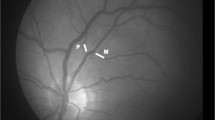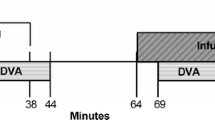Abstract
Background
Diabetic retinopathy is assumed to be due to impaired retinal autoregulation, involving both pressure autoregulation and metabolic autoregulation. The disease displays regional differences, with signs of hyperperfusion in the macular area and capillary occlusion with retinal ischemia in the peripheral retinal areas. It can be hypothesized that these regional differences in the occurrence of retinopathy lesions may reflect differences in the capacity of retinal arterioles to autoregulate the diameter of retinal arterioles.
Methods
Seventeen normal persons and two matched groups of patients with respectively diabetic maculopathy and proliferative diabetic retinopathy were examined. The diameter change of a macular and a peripheral retinal arteriole during an increase in the arterial blood pressure induced by isometric exercise, during an increase in retinal metabolism induced by flicker stimulation, and during both stimulus paradigms simultaneously were studied using the dynamic vessel analyzer (DVA).
Results
During isometric exercise, the diameter response was reduced in both macular and peripheral retinal arterioles in the two groups of patients with diabetes mellitus. During flicker stimulation, the diameter response was significantly reduced in patients with proliferative diabetic retinopathy, but there was no significant difference between the responses of macular and peripheral arterioles. During simultaneous isometric exercise and flicker stimulation, there was no difference between the diameter response of macular arterioles in the three groups, whereas the diameter response of macular arterioles was significantly lower in normal persons and significantly higher in persons with proliferative diabetic retinopathy as compared to peripheral arterioles.
Conclusions
Regional differences in the disturbances of the diameter response to increased blood pressure may contribute to the regional differences in the distribution of diabetic retinopathy lesions. In the central retinal areas, the diameter response to increased blood pressure and retinal metabolism interacted in a way that may potentially protect this area from ischaemia, whereas this protective mechanism was absent in the peripheral retinal arterioles. An elucidation of the mechanisms underlying diameter regulation to increased blood pressure and retinal metabolism, and the interaction between these two mechanisms, may help in understanding the pathophysiology of diabetic retinopathy.




Similar content being viewed by others
References
Kohner EM, Patel V, Rassam SM (1995) Role of blood flow and impaired autoregulation in the pathogenesis of diabetic retinopathy. Diabetes 44:603–607
Blum M, Pils C, Müller UA, Strobel J (2006) The myogenic response of retinal arterioles in diabetic retinopathy. Ophthalmologe 103:209–213
Frederiksen CA, Jeppesen P, Knudsen ST, Poulsen PL, Mogensen CE, Bek T (2006) The blood pressure-induced diameter response of retinal arterioles decreases with increasing diabetic maculopathy. Graefes Arch Clin Exp Ophthalmol 244:1255–1261
Sinclair SH, Grunwald JE, Riva CE, Braunstein SN, Nichols CW, Schwartz SS (1982) Retinal vascular autoregulation in diabetes mellitus. Ophthalmology 89:748–750
Riva CE, Logean E, Falsini B (2005) Visually evoked hemodynamical response and assessment of neurovascular coupling in the optic nerve and retina. Prog Retin Eye Res 24:183–215
Bek T, Hajari J, Jeppesen P (2008) Interaction between flicker-induced vasodilatation and pressure autoregulation in early retinopathy of type 2 diabetes. Graefes Arch Clin Exp Ophthalmol 246:763–769
Kristinsson JK, Gottfredsdottir MS, Stefánsson E (1997) Retinal vessel dilatation and elongation precedes diabetic macular oedema. Br J Ophthalmol 81:274–278
Shimizu K, Yoshiharu K, Muraoka K (1981) Midperipheral fundus involvement in diabetic retinopathy. Ophthalmology 88:601–602
Polak K, Schmetterer L, Riva CE (2004) Influence of flicker frequency on flicker induced changes of retinal vessel diameters. Invest Ophthalmol Vis Sci 43:2721–2726
Garhöfer G, Zawinka C, Resch H, Kothy P, Schmetterer L, Dorner GT (2004) Reduced response of retinal vessel diameters to flicker stimulation in patients with diabetes. Br J Ophthalmol 88:887–891
Mandecka A, Dawczynski J, Blum M, Müller N, Kloos C, Wolf G, Vilser W, Hoyer H, Müller UA (2007) Influence of flickering light on the retinal vessels in diabetic patients. Diabetes Care 30:3048–3052
Pournaras CJ, Rungger-Brändle E, Riva CE, Hardarson SH, Stefansson E (2008) Regulation of retinal blood flow in health and disease. Prog Retin Eye Res 27:284–330
Mandecka A, Dawczynski J, Vilser W, Blum M, Müller N, Kloos C, Wolf G, Müller UA (2009) Abnormal retinal autoregulation is detected by provoked stimulation with flicker light in well-controlled patients with type 1 diabetes without retinopathy. Diabetes Res Clin Pract 86:51–55
Acknowledgements
The study was supported by the VELUX Foundation, Jochum and Marie Jensen’s Foundation, Petrea — Marius Claus — and Erik Feldthusen’s Foundation, and the Augustinus Foundation.
Author information
Authors and Affiliations
Corresponding author
Additional information
Financial relationship
None for any of the authors
Rights and permissions
About this article
Cite this article
Skov Jensen, P., Jeppesen, P. & Bek, T. Differential diameter responses in macular and peripheral retinal arterioles may contribute to the regional distribution of diabetic retinopathy lesions. Graefes Arch Clin Exp Ophthalmol 249, 407–412 (2011). https://doi.org/10.1007/s00417-010-1549-9
Received:
Revised:
Accepted:
Published:
Issue Date:
DOI: https://doi.org/10.1007/s00417-010-1549-9




